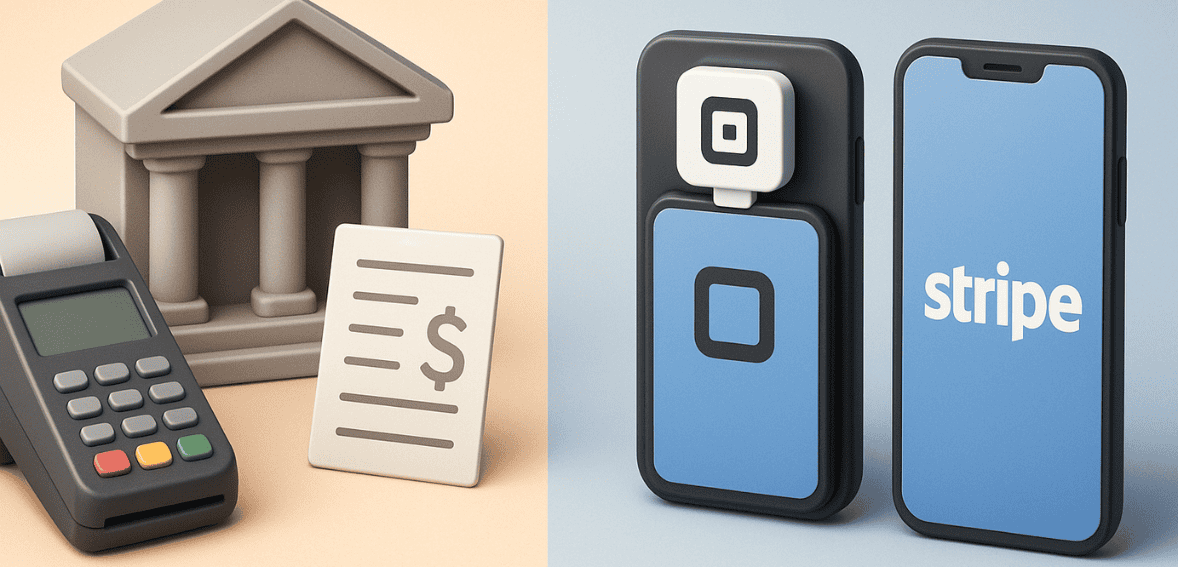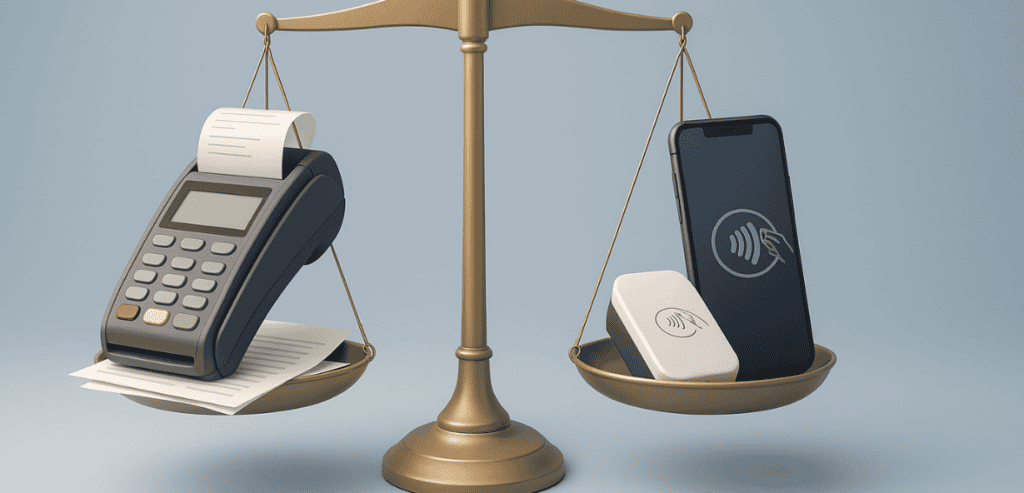The right payment setup is one of your most critical business decisions. And no matter if you own an ecommerce site or store, all the way down to a service-based business, the way that you’re accepting payments plays a crucial role on both the cash flow of the business, the experience of a customer, and the long term viability of a business.
With choices such as Square, Stripe, and traditional merchant accounts, it’s easy to get lost. They all have their own features, fee schedules and benefits and drawbacks. So how do you know what’s best for your business?
This blog explains what you need to understand. You will know about merchant accounts, what payment aggregators including Square and Stripe are and what they offer, and how to compare them based on what kind of business you have. By the time you’ve finished this guide, you’ll be able to understand which payment system can be an ideal option, whether you are just starting out or looking to scale.
Let’s start with the basics first.
What Is a Merchant Account?

A merchant account is a type of business bank account that one attaches directly to credit and debit card payment processing. When a customer pays you money, it first goes into your merchant account. They are deposited to your business bank account after they’re processed (typically within 1-2 business days).
Unlike payment aggregators, a merchant account provider is exclusive to your business. You’ll generally get set up with a payment processor (such as Authorize. Net, First Data, among others) and very likely a payment gateway to handle online payments. That system puts you in charge and allows for more customization (and sometimes lower processing fees — especially if you’re processing a lot of transactions).
Getting a merchant account requires an application and underwriting. The provider evaluates your business and industry type, credit report, and risk level before your account is approved. This makes sure they are dealing with legitimate and stable businesses.
Merchant accounts are common among big online stores, high-risk businesse,s and corporations. Businesses that require the most sophisticated tools, fraud management, and custom integrations also tend to prefer them.
It may sound complicated, but a merchant account provides powerful resources for businesses prepared to grow, and can frequently save money in the long term.
What Are Payment Aggregators like Square and Stripe?

Payment aggregators, also known as payment facilitators are companies such as Square, Stripe, and PayPal, which enable businesses to accept card payments without creating a traditional merchant account. Instead, they group numerous businesses into a single master merchant account.
This arrangement makes things simple and uncomplicated. There is no long application or underwriting process. You can sign up online and begin accepting payments in minutes. This is why freelancers, startups, and small businesses especially appreciate payment aggregators.
Square and Stripe are a jack of all trades—providing all-in-one solutions that include payment processing, mobile card readers, invoicing, and even e-commerce tools. They manage your risk, deal with PCI compliance, and provide fundamental fraud protection features.
But as they take on more risk, they also have strict rules. If your business generates a high level of chargebacks or unexpected activity, they may freeze your money or close your account, without any notice.
Still, for many entrepreneurs, the speed, simplicity, and no-monthly-fee model make Square or Stripe the perfect choice to start accepting payments instantly, especially when flexibility matters more than customization.
Some businesses also typically confuse payment aggregators with payment gateways, but they are different. To get a clear picture of payment aggregators, understand the key difference between them.
Key Differences Between Merchant Accounts and Square/Stripe

When deciding between a merchant account and a payment aggregator such as Square or Stripe, it’s important to compare how they work. Here are some of the key differences:
It’s important to compare how they work in key areas. Here’s a breakdown of the most critical differences:
1. Setup Process
- Merchant Accounts: Require an application, underwriting, and approval. You’ll submit business details, credit info, and possibly financial statements.
- Square/Stripe: Sign-up takes minutes. No underwriting or waiting period. Perfect for quick setup.
2. Fees
- Merchant Accounts: May offer lower transaction fees, especially for high-volume businesses. However, you’ll likely pay monthly fees, gateway fees, and sometimes PCI compliance fees.
- Square/Stripe: Charge a flat fee per transaction (e.g., 2.9% + 30¢), with no monthly costs. This is predictable but can get expensive as your volume grows.
3. Payout Speed
- Merchant Accounts: Typically deposit funds in 1–2 business days.
- Square/Stripe: Standard deposit time is also 1–2 days, but holds can occur more frequently, especially with large or suspicious transactions.
4. Chargeback Handling
- Merchant Accounts: Offer more flexible and customized chargeback management. You often deal with a provider who can guide you.
- Square/Stripe: Automate chargeback handling. Limited appeal options and strict deadlines can make disputes harder to win.
5. Scalability
- Merchant Accounts: Designed for growth. Ideal for businesses processing over $20,000/month. You get better rates, more customization, and dedicated support.
- Square/Stripe: Great for getting started, but may become limiting or costly as you grow.
6. Risk Tolerance
- Merchant Accounts: Suited for higher-risk or niche industries (e.g., travel, CBD, firearms).
- Square/Stripe: May reject or suspend accounts in these industries altogether.
Pros and Cons of Merchant Accounts
Ultimately, you have to consider the pros and cons before determining that a merchant account is right for you.
Pros of Merchant Accounts
Lower Processing Fees:
If your business is processing volumes of transactions, customized rates may potentially save you thousands in comparison to flat fees from aggregators.
Personalization and Versatility:
Customized solutions like custom checkouts, advanced fraud tools, and custom reporting are available with merchant accounts.
Better Chargeback Support:
If you have a dedicated provider, you’re more likely to receive custom assistance when you’re stuck in disputes, which can increase your chances of winning chargebacks.
Support for High-Risk Industries:
High-risk industry businesses can still secure a merchant account to partner with them, which is unlike aggregators that frequently decline these businesses.
Cons of Merchant Accounts
Complex Setup:
The application process can be lengthier and more detailed. Sometimes it can take days or weeks to get your application approved.
Monthly Fees and Minimums:
Many merchant accounts come with monthly fees and minimum transaction amounts that you must meet even if business is sluggish.
More Management Required:
You might have to handle your own gateway, PCI compliance and integration with your website or point-of-sale system.
Although the functionality provided by merchant accounts can certainly be beneficial to established and growing companies, it may be too much for a startup or solo entrepreneur who are getting started.
Pros and Cons of Square/Stripe
For a convenient solution and ease of use, many small and new businesses turn to Square and Stripe — and with good reason. Here’s the breakdown on the pros and cons of using these payment aggregators:
Pros of Square/Stripe
Fast and Easy Setup:
You can sign up and start receiving payments in minutes. No paperwork, no waiting for approval.
No Monthly Fees:
Their pay-as-you-go model is ideal for small business and side hustle owners. When you make a sale, you pay only.
All-in-One Tools:
Square includes point-of-sale systems, eCommerce integrations, invoicing, and reporting. Stripe offers powerful APIs, subscriptions, and marketplace support.
Great for Low Volume:
If you process under $10,000 per month, flat-rate pricing is simple and predictable—ideal for new businesses.
Cons of Square/Stripe
Flat Fees Can Add Up:
The ease has a price. Flat-rate pricing (such as 2.9% + 30¢) can become more expensive as your volume increases.
Risk of Account Holds:
Aggregators automatically watch for risk. If anything seems off, they can freeze your money or put your account into lockdown with little notice.
Limited Customization:
You don’t have as much control over processing settings, chargeback management or payment flows as you would with a typical merchant account.
Square or Stripe is the simplest way to start for many businesses — but not always the best long-term answer.
Choosing the Best One for You

The decision between a merchant account and payment aggregators (like Square or Stripe) really comes down to the size of your business, your industry, and your specific business goals. Here’s some general advice to steer you in the right direction:
For Small and New Businesses
Start with Square or Stripe. They are relatively easy to set up, charge no monthly fees and are a good option for businesses that don’t process high volumes of transactions. They help simplify the process of accepting payments so you can get back to building your business, and not dealing with technical implementations.
High-Volume or Expanding Businesses
When you scale your business to over a few thousand dollars per month in sales, then you want to look at a merchant account. Lower processing fees and customizable capabilities can save you money and offer greater flexibility as you grow.
For High-Risk Industries
If you’re in a high-risk industry (i.e. travel, CBD, or adult product), then a high-risk merchant account is typically the best choice. Payment aggregators such as Square and Stripe could either not service your business model, or they might close down your account because of liability concerns.
Consider Hybrid Solutions
If you’re scaling or can take advantage of redundancy, use both solutions. For routine transactions, Square or Stripe can process it; and for higher-volume or higher-ticket sales, you will need a merchant account.
Ultimately, the best choice comes down to your business model, transaction volume, and growth trajectory. Always check out your options and make sure they fit your business, product and brand goals.
Conclusion
Deciding whether to opt for a merchant account or whether to utilize solutions such as Square or Stripe simply comes down to your business needs. Square and Stripe are the top choices for neat and quick solutions. Businesses that require more customization, flexibility or long-term cost savings can benefit from a merchant account. Consider your transaction volume, growth prospects, and operational requirements before you decide. The right decision leads to smoother engagements, more confidence from the customer and in the end, better business and faster growth.
Frequently Asked Questions
- What is the main difference between a merchant account and Square or Stripe?
A merchant account is a dedicated bank account for processing payments, while Square and Stripe are payment service providers that bundle the merchant account and payment gateway together for easier setup and use. - Is it cheaper to use a merchant account instead of Square or Stripe?
It depends on your business volume. For high-volume businesses, a merchant account often offers lower per-transaction fees. For smaller businesses or startups, Square and Stripe flat rates may be more affordable and predictable. - Can I grow my business using only Square or Stripe?
Yes, many businesses grow successfully using Square or Stripe. However, as transaction volume increases, you might later switch to a merchant account for more competitive rates and greater flexibility. - Are merchant accounts harder to set up than Square or Stripe?
Yes. Merchant accounts usually require a detailed application, credit checks, and underwriting. In contrast, Square and Stripe allow instant setup with minimal paperwork. - When should a business consider switching from Square/Stripe to a merchant account?
Switch when your transaction volume grows, your fees become too high, or you need more customized payment solutions and direct control over processing.
